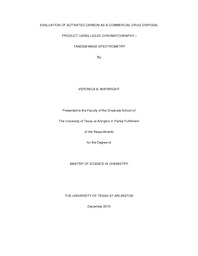| dc.description.abstract | At present, pharmaceuticals, synthetic organic compounds, and endocrine disrupting compounds are ubiquitous in our environment. These have been introduced by consumers and manufacturers directly and indirectly for decades. There is plenty of published literature addressing the presence of these compounds, the development of newer and more sensitive techniques to detect them at low concentrations, as well as studies showing their effects in the environment and in human health. However, these studies are based on the measurement and detection of these compounds after the fact; and even though some have addressed the need to decrease these pollutants in the environment, procedures to minimize the presence of these compounds in the environment have not been firmly established yet at the consumer level. Consequently, the study of processes to decrease the introduction of these pollutants is well justified.
The purpose of this project was to develop a series of methods and experiments to measure the adsorption capacity of a commercial drug disposal product, composed primarily of activated carbon in an acidified solution. Some sample bottles were obtained commercially and contained a proprietary formula, and some sample bottles containing activated carbon in acidified solution were prepared in house. A liquid chromatography – mass spectrometry method was developed and applied for the simultaneous quantification of 24 drugs, which included opiates, barbiturates, statins, amphetamine, and benzodiazepine. For this method, 8-oz bottles containing a proprietary composition were loaded with expired or unused prescription drugs by a third party and the residual was quantified. Additionally, this method was used to measure the loading capacity of activated carbon in 8-oz bottle samples and in 1-gal jug samples. In the case of 8-oz samples, the effect of different acids was also investigated. The loading experiment consisted of the addition of a known amount of acetaminophen in solution every 48 hours or longer, followed by the extraction of the supernatant. A 1-gal jug sample was also prepared in house with known amounts of activated carbon and acidified solution. The 1-gal jug sample was loaded with acetaminophen (500 mg) caplets in solid form instead of acetaminophen in solution. In all of these loading experiments, acetaminophen was chosen because it is used in higher doses in comparison to other drugs (codeine, hydrocodone, etc). In the same manner, aliquots from the 1-gal jug sample were extracted prior to the addition of more acetaminophen caplets. Furthermore, a second method was built to study the adsorption capacity for removal of bioactive species (cannabinoids) from plant matter. In this case, 8-oz bottles were prepared in-house with known composition of activated carbon and acidified solution. 8-oz bottles were loaded by a third party and residuals were tested.
The outcome showed that the drug disposal formulations are able to sequester the active ingredient of 24 (solid and liquid forms) drugs and biologically active cannabinoids successfully. Furthermore, the results of studies used to investigate the loading capacity of large volume formulations demonstrated that adsorption is slow, and that the capacity of the formulation was not reached within 48 hours. If allowed to stand longer, the adsorption increased, but further experiments are needed to investigate these results. | |


